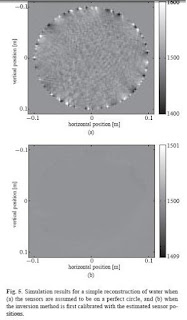As most of you know, I pay special attention to the issue of calibration, so this paper really looks like a very interesting way to go about it: Calibration for Ultrasound Breast Tomography Using Matrix Completion by Reza Parhizkar, Amin Karbasi, Sewoong Oh, Martin Vetterli. The abstract reads:
We study the calibration problem in circular ultrasound tomography devices for breast imaging, where the sensor positions deviate from the circumference of a perfect circle. We introduce a new method of calibration based on the time-of-flight (ToF) measurements between sensors when the enclosed medium is homogeneous. In the presence of all the pairwise ToFs, one can estimate the sensor positions using multi-dimensional scaling (MDS) method. In practice, however, we are facing two major sources of loss. One is due to the transitional behaviour of the sensors and the beam form of the transducers, which makes the ToF measurements for close-by sensors unavailable. The other is due to the random malfunctioning of the sensors, that leads to random missing ToF measurements. On top of the missing entries, in practice an unknown time delay is also added to the measurements. In this work, we show that a matrix defined from all the ToF measurements is of rank at most four. In order to estimate the missing ToFs, we apply a state-of-the-art low-rank matrix completion algorithm, OPTSPACE . Then we use MDS in order to find the correct positions of the sensors. To confirm the functionality of our method in practice, simulations mimicking the measurements of a circular ultrasound tomography device are performed.
The use of low rank matrix completion in this problem reminded me of the use of new techniques like isometric embedding in : Looking Around the Corner using Transient Imaging by Ahmed Kirmani, Tyler Hutchison, James Davis, and Ramesh Raskar. as mentioned a month ago. Both physics deal with time of flight but that's where the physics stops being the same.
From the same authors, we also have these two conference papers:


No comments:
Post a Comment